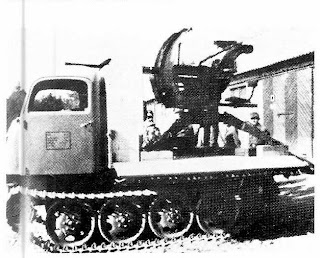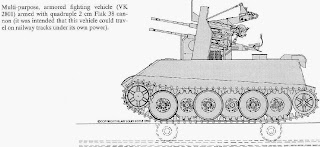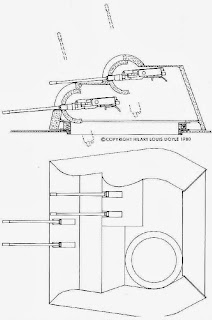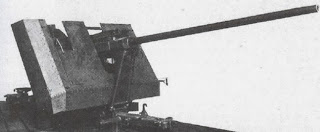The lack of air superiority became quite a problem for the German army in both World Wars.
Very often you will hear people spouting about “invincible Tigers only defeated by enemy airplanes”, which of course was only somewhat true until the Soviets started fielding 122 and 152mm self propelled guns, not to mention the IS series, while British and Americans also put 76mm high velocity cannons to good use on the other side.
The Germans of course were aware of the consequences of loosing air superiority and developed several solutions, of which we will cover only the ones based on tank hulls, ranging from sensible battlefield modifications to daring paper tanks that never reached the battlefield, using mainly “Gepard” by Spielberger and “Panzer Tracts 20-2” by Jentz & Doyle.
2cm Flak 38 auf Panzer I A
Possibly the very first German attempt at a flak panzer, in 1941 at least 18 by then obsolete Panzer I ausf A chassis were converted into a flak panzer using the ubiquitous 2cm flak 38 and were used with moderate success of the battlefield until Stalingrad, where the last tanks were lost.
2cm Flak 38 auf RSO
A relatively simple modification of the “Ost” tracktor, it was developed as AA/Ground support vehicle for mountain troops. Given similar experiments with the heavier PAK 40 the design seems reliable enough, especially given the dismountable gun specification.
Developed in 1943, it never entered service.
Early modifications based on Panzer 38(t)
Between 1943 and 1944 over 150 of those tanks were produced, putting yet again the 2cm flak 38 in a Marder-like configuration. By then though, their firepower left a lot to be desired but as in late war everything that could be used was fielded, they ended up serving until the very end.
A second attempt was made relatively quickly to make a more flexible configuration, ending up in a recon/AA hybrid armed yet again with the 2cm flak 38 and a MG42, a configuration that would resurface on Paper for the 38D design later on.
Using the sd. kfz 222 turret, 70 of those vehicles were made.
Luftwaffe projects on Luchs/Leopard/VK2801 hulls
In September 1943 Krupp and Rheinmetall were requested to submit designs for a light flakpaner carrying the 3.7cm flak 36 (then upgraded to flak 43) or quadruple 20mm flak 38.
The proposal was based on the Luchs but later on maximum integration with Leopard components resulting in a 25 ton tank.
Ground support role was also planned for the tank so the turret had a respectable 50mm front and 30mm sides armor, enough to face most light tanks.
Several configurations were proposed, including the use of a single 5cm Flak 41 or Gerat 58 but ultimately the project was aborted due to the cancellation of the Leopard tank by Speer.
The very same studies were conducted on the VK2801, likely as waffentrager as the same hull configuration was planned to carry the 75mm L/70, although limited to an traverse angle of 15° to each side until the chassis development was aborted in 1945.
Panzer IV based modifications
Being disappointed with earlier attempts, in 1943 Krupp was called in to develop a better solution based on Panzer IV chassis.
The very first solution was to still use the 2cm flak 38 but now in a “Vierling” or quadruple configuration.
This gave a much more intense barrage capability although still relatively short ranged.
Unfortunately the tank was not without drawbacks, resulting in very tall sides when enclosed (earning the nickname of “Mobelwagen” or furniture wagon) and in an unprotected crew when in firing position.
Additional requirements such as entrenching tools and a big supply of hand grenades for close defense (imho this was useless, the main guns could mince meat anything the grenades were meant for at much longer ranges and that close the crew would have been dead meat long before exhausting the grenade supply) meant that insufficient ammo was carried and thus the vehicle never left prototype stage.
A second attempt involved using a newer gun, the 3.7cm Flak 43:
While seemingly puny, the gun was a much stronger advancement from the early 1936 “door knocker” and it could dish out punishment at considerable distances spitting lead up to 250 RPM and also pretty effective against tanks when using special ammunition able to penetrate up to 140mm/0° at 100m.
Both proposals evolved into slightly more compact 22ton turreted designs, called “Ostwind” (east wind, armed with the 3.7cm flak 43), and “Wibelwind” (with the quadruple 20mm) which got over 100 tanks in production.
A derivative prototype was made out of Panzer III chassis but it never reached production.
Another design was an enclosed turret with twin MK 103 cannons using a turret derived from U-boat AA, called the Kugelblitz, or ball lighting with about 80 of those being produced:
Of course, being nice designs with reasonable features wasn’t enough and like everything else it was brought to the extremes late in the war.
In order to gear up the Wibelwind, the “Zerstorer 45″ program was started, bringing a slightly larger turret to mount this:
Quadruple 30mm MK 103 cannon, enough to make minced meat of even the vaunted IL-2 and most light tanks on ground. Only two of those prototypes were made but the hail of fire must have been impressive.
At the same time, Ostwind was planned to be upgraded to “zwilling” or twin, 37mm Flak 43, basically going akimbo:
This was later on planned to be upgraded to the slightly more powerful 3.7cm flak 44.
An heavier configuration was developed in 1942 based on a special Panzer IV chassis mounting the 8.8cm Flak 37 or Flak 41 in a fold-able platform that was later on proposed to be integrated first with Leopard components then with Panther ones but was ultimately discarded for more compact solutions using either 3cm MK 103 or the 5.5cm Gerat 58.
Later modifications based on Panzer 38(t) and 38(d)
As the Panzer IV was scheduled to be phased out, design moved on what was supposed to be its closest replacement, the Panzer 38(d) which could be described as looking like a turreted Hetzer redesigned to be produced in Germany.
Although not evident in the drawing, it sported two 20mm MG 151/20 cannons allegedly for ranging and two MK 103 for the kill, an impressive weapon array for such a compact design.
Later on during flak Panther development the 3.7cm flak 44 was also proposed for the Panzer 38(d).
A final modification was made on an enlarged 38(d) chassis in a waffentrager configuration, using the Gerat 58 in a twin mount.
Panther based modifications
As soon as Panther design started being finalized, flak panzers were being discussed with the very first proposals coming from Luftwaffe in 1942.
Initially a quadruple 20mm MG 151/20 configuration was proposed and trialled but while delivering an impressive barrage, it was deemed insufficient and discarded for twin 3.7cm flak 43.
This configuration, dubbed the “Coelian”, was later on upgraded to twin 3.7cm flak 44, which benefited from a longer, more powerful cartridge.
This was again upgraded in 1944 to make use of the new 5.5cm Gerat 58 still in a twin configuration.
Developed by Krupp and Rheinmetall, this impressive weapon could be elevated from -5° to +80°, firing its ammo at over 1000 m/s and 120-140 rounds per minute per gun.
The heaviest modification however regarded using the 8.8cm Flak 41 in an open turret, proposed in 1943 by Rheinmetall and discarded in 1944 as Panther chassis were direly needed for heavier tasts and 8.8cm cannons in fixed positions were felt more than adequate for the task.
Modifications by Porsche
Development of a light flak/ground support chassis by Porsche in collaboration with Rheinmetall started in 1943 as resources for heavier designs were drying up, using the 3cm MK 103, 5.5 cm MK 112 and the 10.5cm LEFH 43.
60mm frontal armor and a top speed of 58 KM/H would have made this tank double wonderfully as light scout and support, although that role would have been better covered by its enclosed turret version.
All in all, the germans developed quite a few interesting designs of varying effectiveness, especially as planes got faster and faster.
As with similar designs from other nations, the germans basically focused on sheer rate of fire for closer ranges, while using heavier guns was rapidly becoming the chosen option in later vehicles.
As analogous designs to the soviet ZSU 37 and 57 they could have lasted as anti helicopter/light ground support tanks even after the war, until being ultimately supplanted by a mix of SAM and Radar-equipped SPAAGs.























Hey, why no flak bus here?
http://1.bp.blogspot.com/-yTmOlkTbbXM/UsXMwd1GIZI/AAAAAAAAAdY/PjSbHyK9Aww/s1600/pz+sfl+IV.jpg
Flak bus was used with lowered sides…
Same as “2cm Flak 38 auf Panzer I A” – which is even modelled in WT. Since generally no AA in WoT i see no point of lowered sides argument.
It’s generally part of AA design tree so i think it should be called again here ;) .
Can’t you notice that the pic from Zarax is exactly the same used in this article, with the following description?
“An heavier configuration was developed in 1942 based on a special Panzer IV chassis mounting the 8.8cm Flak 37 or Flak 41 in a fold-able platform that was later on proposed to be integrated first with Leopard components then with Panther ones but was ultimately discarded for more compact solutions using either 3cm MK 103 or the 5.5cm Gerat 58.”
Flak Bus IS in that article.
Seems more like a WT Pz. 4 to me..
are you for real ?
“A derivative prototype was made out of Panzer III chassis but it never reached production.
Another design was an enclosed turret with twin MK 103 cannons using a turret derived from U-boat AA, called the Kugelblitz, or ball lighting with about 80 of those being produced:”
At Tier 4 or Tier 5 with normal +/-2MM this tank would be fun.
Luchs and Leopard have to make-do with a single MK 103, I doubt something equipped with two would have normal MM.
But they are scout tanks. This would be medium right?
War Thunder Ground forces will have the AA tanks. :3
How do you mean will have? It has the Flakpanzer I already.
can’t wait Open beta version :)
Wrong Blog. Will be marked for trolling and pant-pulling-downs.
*pulls Balage’s pants down*
PZ4. AA variants would rock on WT…i freaking love flak vierling :P
Those IL-2s are finally going to suffer !
Good article as usual.
This is why I read FTR :)
Great Article!
But (*Grammer-Nazi*) you wrote “Wibelwind” instead of “Wirbelwind”.
Thanks for this Article and your good work.
Yes, bugged me aswell.
Sorry guys, the article took a lot of work and left me drained for proper proofreading…
To be a really unpopular Grammer-Nazi: “An heavier configuration was developed”
Only “A” instead of “An” would be right.
Talking about grammer : isn’t it a mistake to write “necessery” as SS always does ? or is it maybe an intended pun ?
That 37 mm gun… could be something mounted on the AFK Panther ingame?
55 dmg
140 mm pen
0.34 accuracy
10 shells in the clip.
Not that great pen but being able to unload 550 dmg into the ass of a KT in 2 sec would be fun.
140mm would be the gold pen.
You’d have better luck with the Gerat 58.
Even with 140pen it won’t make AwfulPanther less awful. Against 10tier tanks you need something more serious.
It’d still be funny though, you’re not going to be facing 15 maus or E-100 EVERY game.
APCR as standard ammo, or “newly discovered better pen ammo” (as on many premiums) can also be a very good solution.
140mm is the uranium round, can’t get better than that.
It’s a bit confusing at times and VERY poorly put together (why didn’t you put the name of each individual vehicle above its picture? That would have made for a much easier read, and more informative, too), but otherwise a neat article.
A little bit hard to read, not very easy to match a picture with name of a vehicle. ;)
Yeah, I couldn’t come with a better way without copying Spielberger and that was confusing to start with.
Gepard has plenty of good stuff but it’s quite confusing on its own.
Where is the VK 2801 drawing from?
Gepard
Oh, I didn’t notice that in the article.
Hmm, there are completely different drawings in Panzer Tracts.
Deez gunz got a lotta dakka, Boss! :D
80 kugelblitz ? closer to 8 AFAIK
I pulled the number from Spielberger, possibly a typo there?
Chamberlain & Doyle go as low as two ( maybe 5 ) and Hart & Hart also keep it at 5
“Invincible Tigers only destroyed by enemy airplanes!”
If you include self-propelled artillery (Esp. ISU-152 and M7), that’s actually not that inaccurate. And let’s be honest, to a Tiger commander there’s not a terribly large difference between a P-47 strafing run and a Sexton II barrage.
A P-47 strafing wouldn’t do much to a Tiger, it’s direct hits from rockets and bombs that hurts.
Which P-47 happens to be a dedicated carrier of. :) Also, its shower of .50 cal might not penetrate the heavy’s armoring but would probably reap apart all “soft” exterior elements, and for sure deafen the entire crew ! Also, Tiger’s roof stayed 25mm think until 1944, many aircraft carried guns could defeat such a thickness, IIRC.
German Flakscout line now.
I just love the idea of driving around a Kugelblitz at tier 6.
Keep calm and DAKKA DAKKA DAKKA!
grammar nazi No.2
“consequences of loosing air superiority” : loosing? I believe you meant losing, loosing is a completely different animal ;)
I find these infos very useful,thanks SS :)
I see the Porsche design uses the same suspension and bogie type as the Maus.
“while British and Americans also put 76mm high velocity cannons to good use on the other side.”
Actually the Tiger Abteilungen pretty much laughed hard about almost all the British and American tanks and their weak guns. They were not able to penetrate their armor. Same with the T-34/76 (T-34 ingame), the soviet standard tank.
Cool tanks great article.